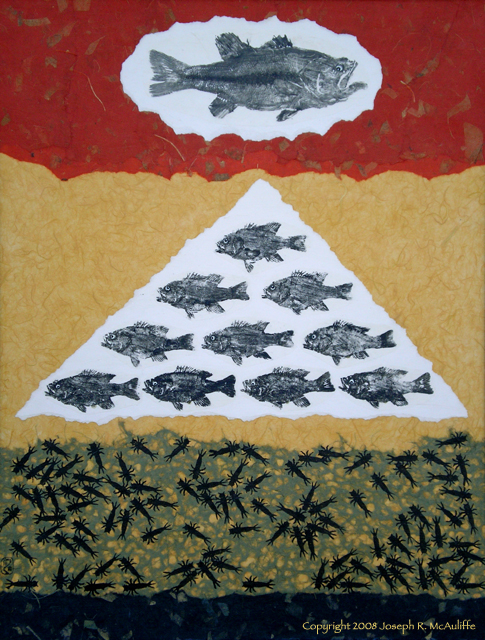
A “bass pond” contains far fewer bass than small sunfish on which the bass prey. Likewise, fewer sunfish swim in a pond than the many insects, small crustaceans, and snails eaten by sunfish. These very small prey in turn are fewer – both in number and total weight – than their food source consisting of the myriads of microscopic plants drifting in the water and growing on the bottom. This fundamental pattern of nature where few predators are supported by large numbers of those on which they feed repeats itself everywhere on land and beneath the waves. In the 1920s, British ecologist Charles Elton named this pattern the “pyramid of numbers.” Today ecologists refer to the concept as a “trophic pyramid” or reverently as an “Eltonian pyramid.” Since Elton’s time ecologists have studied the fundamental constraints that determine the shapes of these pyramids.
Sunlight is the source of energy that is ultimately passed along to all levels of the trophic pyramid, including top predators. However, only the plants are able to capture and store the energy of the sunlight. Animals must obtain their energy by either eating plants or other animals. When an herbivore eats a plant, only a small fraction of the energy stored in that plant food can be converted directly into animal flesh. Most of the consumed energy is instead required by the animal simply to do the varied and never-ending work of staying alive. The living machinery of an animal’s body involving breathing, manufacturing new cells to replace worn-out ones, and moving about in search of more food to keep everything running smoothly all requires a non-stop supply of energy. This loss of energy in doing all this work occurs every time energy is transferred from one level to the next as one creature eats another. Consequently, the amount of energy available to support a population of predators at the apex of the pyramid is but a fraction of a fraction of a very small fraction of the amount of the sun’s energy that was originally captured and stored by plants. Trophic pyramids seldom tower more than a few levels beyond plants simply because too little energy is left to support additional levels of “super-predators.”
Over the last half century, though, humanity has increasingly behaved as such a super-predator on the high seas. Technological advances in electronic fish-finding devices and mechanical fish-catching gear have allowed us to go after large predatory fish that originally were at the tops of marine trophic pyramids. In parts of the Atlantic Ocean, populations of many species of large sharks, including the great white, have crashed and virtually disappeared within the past few decades due to unsustainable extraction by humans. In some cases we have replaced the top predators by subsequently switching our predatory attention to smaller fish in the next lower trophic level – in effect, “fishing down” the food chain. Such a manner of extraction literally mines the trophic pyramid from the top down, deconstructing it on the way due to the short-sightedness in the way we are using the earth’s resources.
This composition is in reverence to all levels of trophic pyramids from top predators down to the foundation of green plants. It represents an exploration of what I call “gyotaku collage” using Japanese techniques of layering and joining paper. One top predator, a largemouth bass, is supported by 10 sunfish, which in turn are supported by 100 insect larvae. The fish are gyotaku and the insects are inked impressions made with a stamp carved from a rubber eraser. The papers include white mulberry, red mango, yellow unryu, green lace, and black and olive mango. The horizontal bands of the different trophic levels are tied together with subtle color highlights in the various papers and represent the interconnection of life. The red mango paper surrounding the bass contains subtle yellow highlights that match the bright yellow zone beneath it. Similarly, the green lace paper shows the yellow background through its open fabric.
Size: 34 x 27 inches (1999)
Return to Gallery 2.